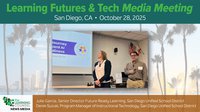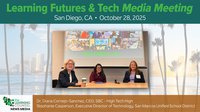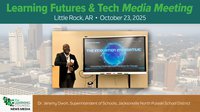Schools and districts are calling the Learning Counsel asking for advice on what to do given they must shut down. We’ve developed this questionnaire so you can quickly analyze the direction to go – and call us for the list of appropriate resources you’ll need. We’ve mentioned many in our Special Reports, but there are tens of thousands in the market to chose from and you might need our help.
Question 1: How long will you be “out?” The Learning Counsel considers almost all schools nationwide will be out for the remainder of the school year given the rate of infectious growth of the Coronavirus, the incubation period and risk until warmer weather hopefully rids the population of the threat as much as possible. If you are “out” for a short term and have no infrastructure or a lack of equity of access is at issue, there are still very essential things you must do. There is also training your staff could be doing right now online (Zia Learning, Learning Counsel’s EduJedi Leadership Society training) so that you are built for the next time this happens.
Determine or decide length you will be out. Next decide if you can do any catch-up in summer and how long that might be and how much it will replace the loss of mid-March-May of lost learning time. We recommend if you are already out of school you consider plans that automatically award a reasonable grade for as much as you can without full completion of the work and possibly even any testing. “Clean slate” the year and then only offer online learning that you can actually implement to the end of the year. It’s important to do this to retain your community of learners and give them a sense like they weren’t just fired and are adrift.
Question 2: What do you want to do as a school or district? Pick one of these:
- Continuing per usual schedule, only virtual now, dropping sports & other live extracurricular, use teachers online. What’s good or bad about this choice:What’s good is that you “stay on track” for learning achievement, your academic standards being met, and testing. What’s bad is that almost no schools are prepared for this, teachers don’t know how and you have no pre-built matrix of all lesson plans or students trained to discipline themselves for online learning. Parents are also probably not prepared. If you try this and aren’t really well-constructed, you will possibly have a huge failure plus open up equity gaps of kids whose parents are just not enforcing anything and then complain that it’s the school’s fault. Also realize that time will be different. You really will have a problem if you try to have a full 6-½ hour or 7-hour day from home and maintain all the same sets of between-class breaks, lunch, etc.
- Continue the usual schedule, dropping live extracurricular but adding online extracurricular, use teachers online. What’s good or bad about this choice: Same as #1 above, but you can now work in companies that offer full-courses or courseware online for extra-curricular choices. Plus, you can create community online by setting up discussion groups for each of the extra-curricular courses within your LMS or social sites like Knowstory.What’s bad about this is that you might not be prepared to “replace” your extra-curricular teachers or sideline them indefinitely and need a plan for that. You also will need a plan for how you will do oversight for extra-curricular courses or courseware and that may mean some rapid teacher training.
- Drop the usual schedule and alignment to academic standards or testing, and use limited all new learning (grade & subject relevant), use teachers. What’s good or bad about this choice:What’s good is that this allows you to streamline how you will run remote schedules in a way that most parents or students self-studying can actually do. You can form “houses” of learners out of existing homeroom or main classroom and form group rollcall on student calendars led by your regular teachers. This provides a forum to maintain a sense of community and purpose. You then can use predominately professional-grade courseware and Apps mixed in with some LMS-oriented lesson plans to continue learning less focused on meeting academic standards precisely or testing necessarily because it’s limited in scope of coverage. That’s not to say professional products and some internally built lessons won’t keep you on track, but the idea is to continue learning but sacrifice to some degree the strict requirements and full coverage. The downsides are obvious, such as what to do with teachers and how to organize when and where they are part of the plan, but the upside is that you keep students learning.
- Same as #3, only reorganized for front-line and back-line teaching. What’s good or bad about this choice: Same as #3, with the added benefit of streamlining so that fewer teachers are used to run online guidance and direct instruction while other teachers are allocated for retraining and used to custom build-out digital lessons or learn new courseware needed for a full transition for the next time you need a flexible blended program that allows the physical togetherness to be turned off at will with no loss of progress.
- Rollcall continuity, loose schedule, limited mixed-live and a lot of Courseware, Apps & Sites, teachers limitedly engaged and used to build-forward your lesson workflow. What’s good or bad about this choice: What’s good is that you are disregarding alignment to your schedule and academic standards are testing, and just putting access out to a loosely defined schedule to maintain engagement and a sense of learning. Plus, you are building out the matrix of resources needed to be ready next time. You can still schedule live activities that convene students like a regular rollcall to check-in and make sure all students know what they can be doing with resources. What’s bad is that you are not aligned to your usual course programs and may have to just assign every student their probable grade and hope for the best on any required high-stakes testing. In the meantime, you are gaining the ability to have teachers use their time from home for retraining and learning new courseware so they can grade it as lessons come in, and building out digital lessons for a full transition for the next time you need a flexible blended program that allows the physical togetherness to be turned off at will with no loss of progress.
- Outsourced semi-coverage of curriculum digital content/lesson model and schedule, remainder retained and transitioning teachers meanwhile. What’s good or bad about this choice: What’s good is that you have a reasonable assumption of retaining alignment and very rapid onboarding for all students, even for large districts for your main subjects. Your continuity of learning operations is held at a constant, with perhaps only a couple weeks delay. Meanwhile, you can train teachers and build a reasonable brand of your own that possibly uses some or all outsourced provider’s resources but builds out beyond that for a full coverage mix that fits your students. This is the easiest and fastest model but requires a firm hand by administrators to reassure and reorganize teachers for a workable model that can be both physical and online at will (which is the recommended personalized learning workflow model.) It is recommended all administrators and teachers do the EduJedi Leadership Society training so they can grasp the model that will fit the future, so this emergency situation never happens again. The bad thing is that in this model you are intentionally sacrificing many subject options, which may be something you have to do based on cost.
- Outsourced full coverage digital content/lesson model and schedule, transitioning teachers meanwhile. What’s good or bad about this choice: What’s good is that you have a reasonable assumption of retaining alignment and very rapid onboarding for all students, even for large districts for your all or nearly all subjects. What’s bad is that this will completely sideline the existing staff unless you strike a temporary deal for them to be rapidly trained and used as part of the deployment. Other teachers can be used to build out your own brand mix of all digital resources in the ultimate personalized learning workflow to secure your future.
Question 3: What do you have?
Scenario 1: No Online Learning, no Learning Management System (LMS), no office suites, and maybe a few site subscriptions, apps or courseware only for remedial, intervention, or discrete digitized items like links and documents within lesson plans of various teachers probably use with projectors or interactive whiteboards. No matrix of teaching and learning in sequential order against estimated schedule of grade checksheet of all courses, each course with a coursesheet, each lesson in a course with itemized resources and steps and any formative and summative assessments. Curriculum planning is generalist at district or school level, and each teacher does their own general plan and then weekly lesson planning throughout the year. Administration has no real visibility into front-line lesson work, just the top-line pacing guides.
Scenario 2: No LMS, Office365 or Google & maybe some random Apps or Subscription sites of courseware or discrete curated lesson objects - mostly remedial, supplemental or intervention. Also, no matrix.
Scenario 3: Same as 2 but has an LMS. Probably has some ratio of teachers who use the LMS and some who really don’t.
Scenario 4: Same as 2 and 3, but has an inventory plotted by grade, subject and whether core or supplemental for all resources or at least the subscription courseware and apps.
Scenario 5: Has LMS, using Office365 or Google, lots of apps and subscription sites and has teacher-led workflow built out. This means each lesson has its own lesson sheet of steps and any needed assessment. The lessons have been laid end-to-end across a probable time schedule for the semester or year’s course. Each course has its list of lesson sheets and any needed info like who is the teacher, when and how it will convene and online community. Each lesson has a sequenced list of steps and any needed assessment. Teachers still allocate each checksheet, coursesheet and lesson sheet. There are no automatic algorithms routing learners from one small step to the next which still needs to be done by hand by teachers, but the highways of the subjects are built with sequenced courses and lessons across the full year. This can be done in most LMS’s alongside office suites but is very hard for K-12 to implement at all grade levels because it retains the teacher and whole-group orientation when transitioning to an online scenario. Since almost all online convening will lack some attendance, this scenario is fraught with failure and additionally when acting as a “replacement” to physical presence, would keep kids online for way too long.
Scenario 6: Same as 5, but all grade checksheets, coursesheets and lesson sheets are built as self-directed, which means most of the work and navigation is done by students who convene only as called into online meetups or required lecture online, etc. This moves teachers into guiding, convening to discuss lessons, and doing direct instruction for students falling behind. It transforms to very little lecture-style and way more use of the best-in-class courseware and discrete digital resources versus digitized low-value word documents and try-to-lecture-online.
Scenario 7: Same as 6, but now has lots of systems and Apps and courseware to carry different parts of learning offerings in a sophisticated mix, the most important of which is a separate workflow/forms engine for personalized learning workflow for all checksheets, coursesheets and lesson sheets. This is the “routing” of students to and fro they must follow, in addition to schedule of convening live online. It allows for a complete personalization and changes classrooms to meeting spaces because students are usually in the “house” room and even remote, just scheduled into whole group or small group with teachers per their cohort triggering that on the calendar as it arrives to those points. The workflow also has “byways” off these main highways for further individualization because teachers have predicted “glitch” areas of subjects where students might need remediation, extra practice, etc. The organization is now using teachers as both teachers and guides plus a set of former teachers as on-the-fly lesson builders or guides for students that fall off both the highways or byways or just need some other lesson. Note: this only exists right now in a more manual way in schools. It’s forms put in folders and sub-folders and sub-folders of those. It’s a routing form across all. It’s released materials as students arrive on the next form. It’s logistics. No one has automated all the algorithms needed for auto-cohorting and matchups as needed with teachers to fully uberize learning, but it’s coming. Meanwhile, any school can build out workflow with checksheets, coursesheets and lesson sheets the old-fashioned way by gathering up all teacher lessons and laying them end-to-end like bricks for a pathway. This is not hard. Implementing it, watching the flow and checking in with students, doing interventions and direct instruction, that’s now the work on teachers.
Question 4: What can I do right now?
1. Immediately take an inventory of your systems and digital assets. Plot these into a grid marking these columns: Grade – Subject – Use.
2. Have teachers making lesson plans and putting them in sequential order as “6th Grade Math – Lesson 1” and so forth for the term remaining of the year, later for a full year.
3. Meanwhile, immediately deploy all supplemental App access that you can.
4. Pay attention to community creation and giving all students a sense of belonging every school day to your institution.
5. Start training to become true EduJedi so you can transition your school or district to be flexibly able to handle learning that is on-campus or online with ease.
6. Contact the Learning Counsel to help work out your plan of action, including what companies to partner with for different parts of your plan. We’re not just media and research, we can consult with you directly on a software model architecture and implementation. For parts that we know others will do better, we will recommend them to you.
If you are a vendor we need to know or know better, please also contact us to get on our list of resources and public relations announcements to all readers.
Contact Learning Counsel: Doug@LearningCounsel.com or 888-611-7709 extension: 26
About the author

LeiLani Cauthen is CEO of the Learning Counsel, and author of The Consumerization of Learning.











